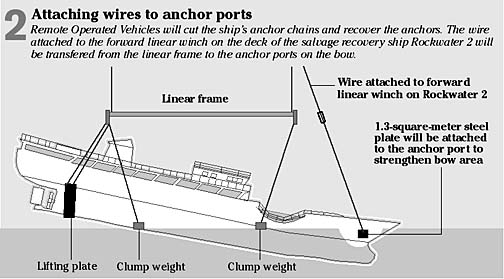


Setbacks will not Despite several setbacks, the Navy says it "remains fully committed" to raising the Japanese fisheries training vessel Ehime Maru and moving it to shallower waters so divers can search for the remains of nine missing people.
stop Ehime lift
The Navy pledges to continue
recovery efforts in spite of costsFormer sub skipper to retire Sept. 30
By Gregg K. Kakesako
gkakesako@starbulletin.comCapt. Bert Marsh, supervisor of salvage for the Navy, also acknowledged yesterday that the unprecedented deep-water recovery operation may exceed its $40 million budget.
Marsh would not estimate how much the latest setbacks will affect the Navy's timetable, which initially set mid-September as the deadline for moving the Ehime Maru to shallower waters because of tide and weather conditions. The Ehime Maru sank Feb. 9 after being struck by the nuclear attack submarine USS Greeneville nine miles south of Diamond Head.
Japanese Foreign Minister Makiko Tanaka will visit Adm. Thomas Fargo, Pacific Fleet commander, tomorrow morning at Pearl Harbor and then spend time with crewmen and divers from the Japanese Maritime Self-Defense Force submarine rescue ship Chihaya. Japanese divers will join the operation after the Ehime Maru is moved to shallower waters.
Yesterday, Marsh described the problems his team of military and civilian international experts have encountered as "evolutionary." Attempts will be made again to slip a wire beneath the hull of the 830-ton ship so it can be rigged to a special cradle and be lifted.
What has stymied Marsh and his crew is placing those special guide wires under the pilot house on the Ehime Maru on the forward part of the ship. Marsh has been able to place one wire near the stern of the ship under the engine room.
"We are now in the process of placing 50-foot-long metal lifting places under Frame 15 (the engine room)," Marsh said.
But the guide wires could not be positioned under the pilot house after snagging on the keel of the ship. Several attempts to partially lift the stern about 23 feet to clear the snag failed when the 5-foot-wide strap broke last Friday and Tuesday.
Marsh said the Rockwater 2, the civilian ship contracted to lift and move the ship to a spot one mile south of Honolulu Airport's reef runway, will try now to partially lift the bow, or the front of the boat, high enough to slide the guide wires under the pilot house.
Marsh said, however, that the Ehime Maru, after repeated attempts to lift it to clear the snagged line, sits 2,000 feet on the bottom with its bow buried in the mud and silt and the rudder up at an angle.
The Rockwater 2 must first dredge an area near the bow so the anchor chains and anchor can be removed and a line attached at that point. Special dredging pumps will have to be flown in from the mainland. Then winches on the Rockwater 2 will pull on the lines attached to both the stern and the bow so a new guide wire can be placed under the forward part of the boat.
The linear winches pulling on the stern and bow lines will be kept in control by a computer, Marsh said. He added that most of the weight of the Ehime Maru is in the stern of the boat. Salvage experts hope to use that to their advantage since as the stern goes down, the bow will rise naturally, like a seesaw, Marsh said.
Two Japanese experts have reviewed and endorsed the modified plan, Marsh said. They also helped design the size of the metal plates.
Marsh said the Navy is confident that the Ehime Maru's hull is strong enough to withstand the pressure of another partial lift.
Once the metal lifting plates are positioned under the engine room and the pilot house, they will be attached to a special cradle. The Rockwater 2 will raise the Ehime Maru 90 feet off the bottom and move it 12.5 miles to the reef runway site. There, a methodical search of the Ehime Maru's cabins will be done for the remains of the four high school students and five others.
Marsh said the recovery operation is now "milestone-driven," and would not give an exact time it would take to complete the lifting operation.
"This remains to be a very difficult operation," Marsh said. "However, we have flexibility in our methods. I still remain very, very confident that we can lift her."



